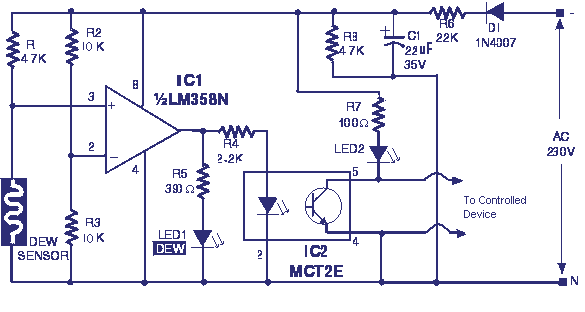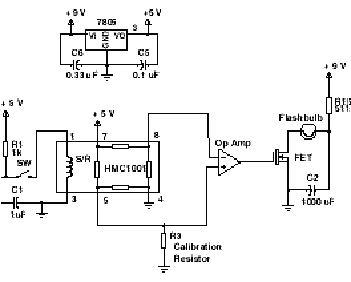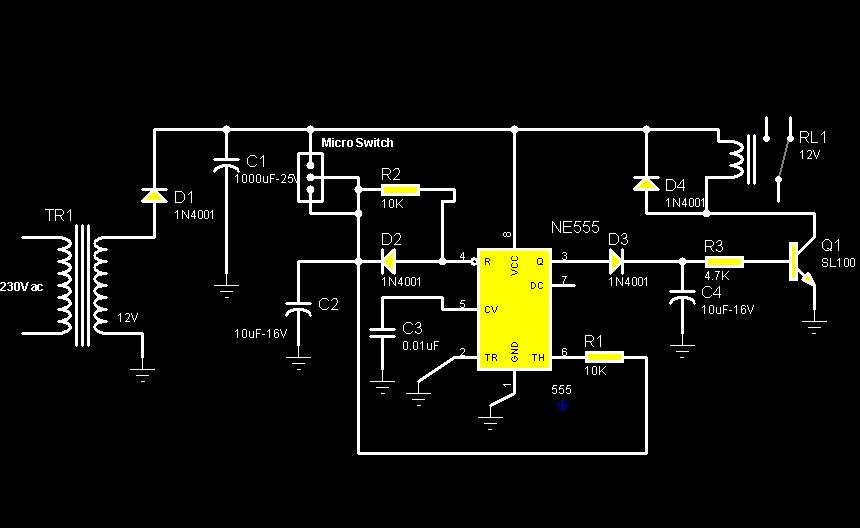
Sensor Circuits

This is a simple mains power failure alarm circuit that activates an alarm when the mains supply is lost. Unlike many similar circuits, this design does not require a backup power source, such as a battery, to operate the alarm in the absence of mains power. When the mains supply is present, the transistor Q1 (BC558) remains OFF, allowing capacitor C1 to charge. If the mains supply fails, transistor Q1 turns ON, causing capacitor C1 to discharge through Q1, which drives the buzzer to sound the alarm. Additionally, there is a dew-sensitive circuit that activates a device when the surrounding dew level exceeds a predetermined threshold. This circuit utilizes a resistive dew sensor and a comparator based on the LM358 IC. Under normal conditions, the resistance of the dew sensor is low, resulting in a lower voltage at the non-inverting input of the LM358 compared to the inverting input, keeping the output of the op-amp low. Furthermore, a digital temperature controller circuit is described, which uses the LM35 temperature sensor (IC3) to provide an analog signal to the ADC 0804 (IC4). The ADC converts this analog signal into a digital output, which can drive eight LEDs to indicate the output logic or be connected to an external temperature control system. Additionally, a low-cost metal detector circuit is outlined, utilizing a single transistor and an old pocket radio. This circuit operates as a Colpitts oscillator, tuned to a medium band frequency. When the metal detector is brought close to a metal object, the sound from the radio changes as the frequency of the oscillator interacts with the metal. Lastly, a simple proximity detector using the CS209 IC is described. The CS209A is designed for metal detection and proximity sensing, featuring an internal oscillator that operates near the resonant frequency of an external tank circuit. As a metal object approaches the inductor, the oscillation amplitude decreases, triggering a response when it reaches a specific threshold.
The mains power failure alarm circuit is designed to provide a straightforward and effective solution for detecting power outages. The use of the BC558 transistor as a switch allows for a reliable operation without the need for additional power sources. The charging and discharging of capacitor C1 play a critical role in the alarm's functionality, ensuring that the buzzer is activated promptly upon loss of mains power.
The dew-sensitive circuit, employing the LM358 comparator, provides a practical application for environmental monitoring. The resistive element's change in resistance due to dew accumulation is a simple yet effective method for sensing moisture levels, making it suitable for various applications, including agricultural and HVAC systems.
The digital temperature controller circuit leverages the precision of the LM35 temperature sensor, which outputs a voltage proportional to the temperature. The ADC 0804’s 8-bit resolution enables the conversion of this analog signal into a digital format, suitable for further processing or display. The option to connect external circuits enhances the versatility of this temperature control solution.
The low-cost metal detector circuit demonstrates an innovative approach to metal detection using basic components. The interaction between the Colpitts oscillator and the radio creates an audible signal that indicates the presence of metal, making it a cost-effective tool for hobbyists and professionals alike.
The CS209A proximity detector circuit exemplifies the integration of a simple oscillator with a metal detection application. This design allows for the detection of nearby metal objects by monitoring changes in oscillation amplitude, providing a straightforward solution for proximity sensing tasks. Overall, these circuits showcase a range of practical electronic applications, utilizing fundamental components to achieve specific detection and control functions.Here is a simple mains power failure alarm/detector circuit that produces an alarm whenever the mains supply fails. Lot of such circuits are available, but the peculiarity of this circuit is that it requires no back up power source like a battery to power the alarm when the mains is absent.
When there is mains supply the transistor Q1 (BC558) will be OFF and the capacitor C1 will be charged. When the mains supply fails the transistor Q1 becomes ON and the capacitor C1 discharges through the Q1 to drive the buzzer to produce an alarm. The capacitor C2 is Here is a simple circuit that can be used to switch ON or OFF a device when the dew present in the surrounding atmosphere crosses a set value.
The circuit uses a dew sensitive resistive element and a comparator based on LM 358 to perform the above said operation. At normal condition the resistance of dew sensor element will be low and so the voltage drop across it.
So the voltage at the non inverting pin of LM358 (IC1) will be less than the voltage at the inverting input of the LM358. So the output of the opamp will Here is a straight forward, yet effective digital temperature controller that can be used with temperature control systems.
The circuit uses IC LM 35 (IC3) to as the temperature sensor. The output of LM 35 is given to the IC ADC 0804 (IC4) which converts the analog output of the LM 35 to digital output. The ADC 0804 is a 8 bit ADC. Eight LED`s are connected to the output of ADC to show the output logic. If needed the LED`s can be avoided and the output can be connected to any suitable external circuit like temperature controller etc .
Metal Detector Circuit Description This is the circuit diagram of a low cost metal detector using a single transistor circuit and an old pocket radio. This is nothing but a Colpitts oscillator working in the medium band frequency and a radio tuned to the same frequency.
First the radio and the circuit are placed close. Then the radio is tuned so that there is no sound from radio. In this condition the radio and the circuit will be in same frequency and same frequencies beat off to produce no sound. This is the set up. When the metal detector circuit is placed near to a metal How to make a simple Proximity detector or sensor Description This is a simple proximity detector using IC CS209.
The CS209A is a bipolar monolithic integrated circuit for use in metal detection/proximity sensing applications. The CS209A contains an oscillator set up by an external parallel resonant tank and a feedback resistor connected between pin 2 & 3.
The internal oscillator operates close to the resonant frequency of the tank circuit. As a metal object is brought close to the inductor, the amplitude of the voltage across the tank gradually begins to drop. When the envelope of the oscillation reaches a certain level, 🔗 External reference
The mains power failure alarm circuit is designed to provide a straightforward and effective solution for detecting power outages. The use of the BC558 transistor as a switch allows for a reliable operation without the need for additional power sources. The charging and discharging of capacitor C1 play a critical role in the alarm's functionality, ensuring that the buzzer is activated promptly upon loss of mains power.
The dew-sensitive circuit, employing the LM358 comparator, provides a practical application for environmental monitoring. The resistive element's change in resistance due to dew accumulation is a simple yet effective method for sensing moisture levels, making it suitable for various applications, including agricultural and HVAC systems.
The digital temperature controller circuit leverages the precision of the LM35 temperature sensor, which outputs a voltage proportional to the temperature. The ADC 0804’s 8-bit resolution enables the conversion of this analog signal into a digital format, suitable for further processing or display. The option to connect external circuits enhances the versatility of this temperature control solution.
The low-cost metal detector circuit demonstrates an innovative approach to metal detection using basic components. The interaction between the Colpitts oscillator and the radio creates an audible signal that indicates the presence of metal, making it a cost-effective tool for hobbyists and professionals alike.
The CS209A proximity detector circuit exemplifies the integration of a simple oscillator with a metal detection application. This design allows for the detection of nearby metal objects by monitoring changes in oscillation amplitude, providing a straightforward solution for proximity sensing tasks. Overall, these circuits showcase a range of practical electronic applications, utilizing fundamental components to achieve specific detection and control functions.Here is a simple mains power failure alarm/detector circuit that produces an alarm whenever the mains supply fails. Lot of such circuits are available, but the peculiarity of this circuit is that it requires no back up power source like a battery to power the alarm when the mains is absent.
When there is mains supply the transistor Q1 (BC558) will be OFF and the capacitor C1 will be charged. When the mains supply fails the transistor Q1 becomes ON and the capacitor C1 discharges through the Q1 to drive the buzzer to produce an alarm. The capacitor C2 is Here is a simple circuit that can be used to switch ON or OFF a device when the dew present in the surrounding atmosphere crosses a set value.
The circuit uses a dew sensitive resistive element and a comparator based on LM 358 to perform the above said operation. At normal condition the resistance of dew sensor element will be low and so the voltage drop across it.
So the voltage at the non inverting pin of LM358 (IC1) will be less than the voltage at the inverting input of the LM358. So the output of the opamp will Here is a straight forward, yet effective digital temperature controller that can be used with temperature control systems.
The circuit uses IC LM 35 (IC3) to as the temperature sensor. The output of LM 35 is given to the IC ADC 0804 (IC4) which converts the analog output of the LM 35 to digital output. The ADC 0804 is a 8 bit ADC. Eight LED`s are connected to the output of ADC to show the output logic. If needed the LED`s can be avoided and the output can be connected to any suitable external circuit like temperature controller etc .
Metal Detector Circuit Description This is the circuit diagram of a low cost metal detector using a single transistor circuit and an old pocket radio. This is nothing but a Colpitts oscillator working in the medium band frequency and a radio tuned to the same frequency.
First the radio and the circuit are placed close. Then the radio is tuned so that there is no sound from radio. In this condition the radio and the circuit will be in same frequency and same frequencies beat off to produce no sound. This is the set up. When the metal detector circuit is placed near to a metal How to make a simple Proximity detector or sensor Description This is a simple proximity detector using IC CS209.
The CS209A is a bipolar monolithic integrated circuit for use in metal detection/proximity sensing applications. The CS209A contains an oscillator set up by an external parallel resonant tank and a feedback resistor connected between pin 2 & 3.
The internal oscillator operates close to the resonant frequency of the tank circuit. As a metal object is brought close to the inductor, the amplitude of the voltage across the tank gradually begins to drop. When the envelope of the oscillation reaches a certain level, 🔗 External reference





